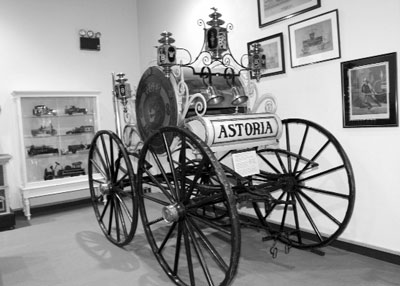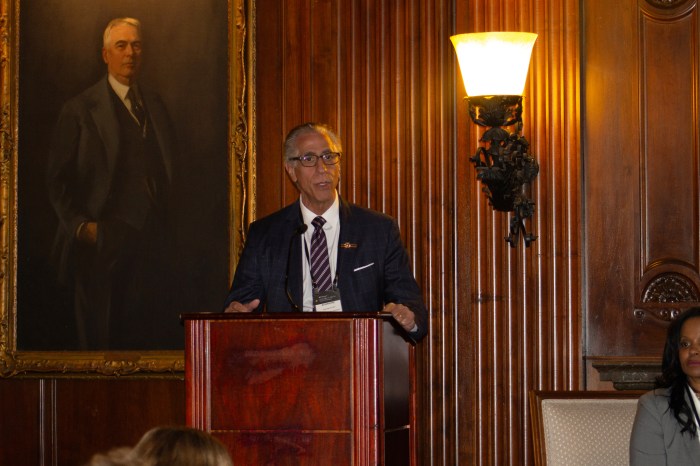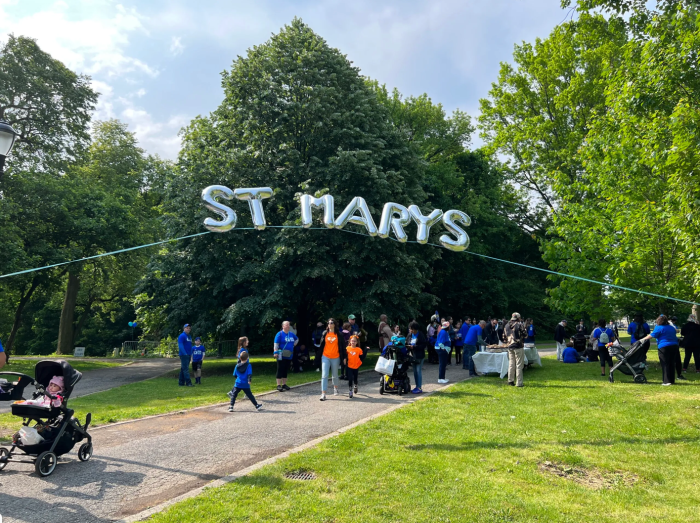By Susan Phillips
New York City Fire Museum
278 Spring St.
Tues. – Sun. 10 AM to 5 PM
Donation: $4 for adults, $1 children.
Birthday party package available. Includes cake, juice and fire theme toys. For more information, call 212-691-1303 or visit www.nycfiremuseum.org.
Housed in the former Engine 30 firehouse on Spring Street between Hudson and Varick, the museum will celebrate its centennial this February. For some of these kids, fire safety hit close to home.
“One time my house burned down and we lived in a shelter,” said one little boy. Another told of how he received an electric shock after touching a live wire on the street.
The Fire Museum, staffed by both volunteer retired firefighters and those on light duty, teaches an estimated 10,000 school children a year about how to detect fire hazards in the home, what to do if they find themselves on fire, and how to escape.
But not everyone comes to the Fire Museum for such serious lessons. Some want to gaze at the beauty and technology of the past, some want to play, and some want a history lesson. The Fire Museum, which receives between 50,000 to 60,000 visitors each year, easily accommodates all with its impressive collection of fire equipment, artifacts and art dating back to the 1700’s. The rear of the firehouse was a stable before motorized engines replaced horses.
Engines, pumpers, tools, wooden water mains, scaling ladders, a life net, and a stuffed firedog are among the more modern artifacts on the first floor. The second floor includes a collection from the pre-Civil War, all-volunteer days, when 140 men, too proud to rely on horses, pulled a Veteran Pumper through the streets of New York. Felt top hats, leather fire helmets, ornate trumpets, painted leather buckets, parade belts and toy fire trucks dating from the late 1700’s to the present, line the walls.
The Steinway Hose #7, a carriage adorned with feathered plumes, polished brass, copper and decoratively painted red, blue, and gold, required the strength of 40 men to pull. Tom Walters, a retired fire fighter and volunteer says that he believes the Steinway that was used in a station near the Steinway piano factory, was funded or built by the company.
Walters, like the other volunteers, is passionate about fire fighting history.
“Once a fireman always a fireman,” he said. “It’s fun, I like being in a firehouse.”
“The kids really like it when we tell them that horses rushed through the streets to the fires,” said retired firefighter and volunteer Jim Moroney. A self-described history buff, Moroney engaged the kids by shaking the rattles used by New York City’s original firefighters. That’s when the city was still the village of New Amsterdam. After a fire destroyed over 300 New Amsterdam homes, Peter Stuyvesant, then governor, hired men to roam the streets at night watching for fires. Stuyvesant also passed a law requiring businesses to own buckets. These “bucket brigades” fought fires with lines of men passing the buckets of water from the rivers to the houses while women and children passed the empties back.
Eight-year-old Jeremy was at the museum with his four-year-old brother Ryan and his aunt, Susan Onuma.
“I thought it was cool, because of all these old-fashioned things I never saw before,” he said. Referring to Stuyvesant’s rattles he added: “A long, long, long time ago they used rattles to wake people up.”
Onuma, who works as a lawyer and lives in New Jersey, said she had come into town to take her nephews to see the Lion King and had some extra time. “It’s a small enough museum to [accommodate] their attention span, which is about an hour,” said Onuma. “For a four and eight-year-old, it’s hard to find things they can both enjoy. Everyone in this area should come to see this museum.”
Natalia Djunic, a resident of Greenwich Village who came with her 3-year-old boy Dennis agreed.
“We’ve been here 40 minutes,” she said. “It’s unbelievable with his attention span.”
The brass fire pole thrilled Dennis, who said he wants to be a fireman.
“If he could try that, he would be the happiest little boy,” said Djunic.
Because of the age of many of the pieces in the collection, children are not allowed to climb on the equipment.
“Parents have to understand this is not a playground,” said museum director Joann Kay.
Despite this, the kids seemed fascinated by the variety of red vehicles that span almost three centuries of fire fighting. And the volunteers provide plenty of living oral history.
“The biggest [asset] are the staff,” said Djunic. “They are excellent, you can hear so many stories from them.”
For older children and adults, a permanent interactive 9/11 exhibit includes photographs; a computerized photojournal of all the firefighters lost, and recovered artifacts from the World Trade Center site.
Former firefighter Moroney says that the older children are interested in the contemporary tools, especially the Jaws of Life, a large reverse pair of scissors used to free people trapped in cars and elevators. The adults, he said, want to hear the history.


















